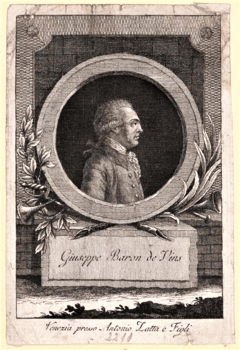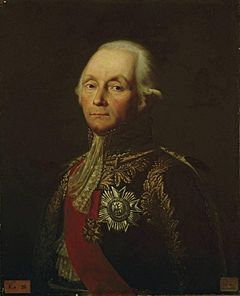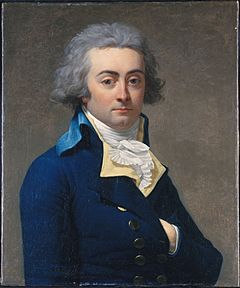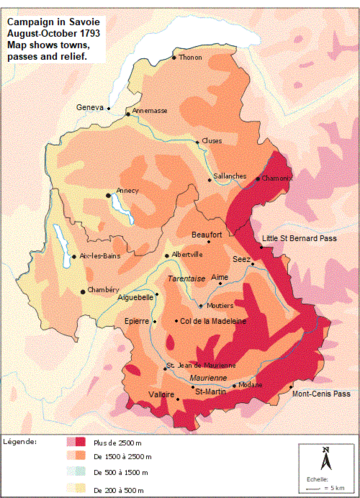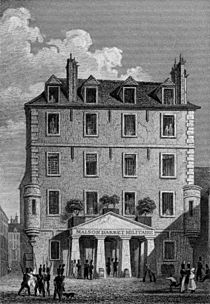Battle of Epierre facts for kids
Quick facts for kids Battle of Epierre |
|||||||
|---|---|---|---|---|---|---|---|
| Part of the French Revolutionary Wars | |||||||
 View of Épierre in the Maurienne valley |
|||||||
|
|||||||
| Belligerents | |||||||
| Commanders and leaders | |||||||
| Strength | |||||||
| Campaign: 12,000 Battle: 8,000 |
Campaign: 18,000 Battle: 6,000 |
||||||
| Casualties and losses | |||||||
| Campaign: unknown Battle: 500 |
Campaign: 2,000 Battle: 1,000 |
||||||
The Battle of Epierre (September 15, 1793) was an important fight during the French Revolutionary Wars. It was part of a bigger conflict called the War of the First Coalition. In this battle, the French army, led by General François Christophe de Kellermann, fought against the army of the Kingdom of Sardinia-Piedmont. The Sardinian army was larger and commanded by Prince Maurizio, Duke of Montferrat.
In mid-August 1793, the Sardinian army, under Austrian commander Joseph Nikolaus De Vins, tried to take back the Duchy of Savoy from the French. The French were busy fighting in Lyon, so the Sardinians managed to recapture most of the Maurienne and Tarentaise Valleys. However, they were stopped before they could reach Albertville.
In September, General Kellermann launched a counter-attack. He cleverly moved his troops between different valleys to push back the Sardinians. At Épierre, a French force led by Jean-Denis Le Doyen defeated the Marquis of Cordon in a smaller battle. By October 8, the Sardinians had to give up all the land they had gained and retreat back into the Graian Alps. Even though Kellermann won, some politicians in Paris were suspicious of him. He was arrested and stayed in prison until November 1794.
Contents
How the Battle Started
Before the War
King Victor Amadeus III of Sardinia was not happy about the French Revolution. But he did not want to get involved in France's problems. His sons-in-law, who later became French kings, fled to Sardinia during the revolution. They caused trouble by planning against the French government. But they both left Sardinia by early 1791.
Historically, many French people wanted to control the Duchy of Savoy and the County of Nice. These lands belonged to Sardinia-Piedmont but were on the French side of the Alps. French leaders believed France should expand to its "natural borders." If France did this, Savoy and Nice would be hard for Sardinia to defend.
In July 1791, King Victor Amadeus asked the Habsburg monarchy (Austria) for help if France invaded. The Habsburgs owned the nearby Duchy of Milan. It was tricky to negotiate with them because they had taken land from weaker nations before. The French government created the Army of the Midi in April 1792. They ordered its commander, General Anne-Pierre, marquis de Montesquiou-Fézensac, to invade Savoy and Nice. His army was not ready, but the Sardinians knew an attack was coming. Victor Amadeus finally got an agreement for 8,000 Austrian soldiers to help defend his kingdom. This agreement was signed on September 22, but it was already too late.
The War Begins
On September 21, 1792, the French Army of the Midi invaded Savoy. General Montesquiou had about 25,000 soldiers. They faced 10,000 to 12,000 Sardinian troops. By September 24, the French were in Chambéry. On September 29, another French general, Jacques Bernard d'Anselme, took Nice with 10,000 troops. The French easily defeated their opponents with little fighting. The 70-year-old Sardinian commander, General Lazary, was not very good at his job.
On October 1, 1792, the French government divided the Army of the Midi. It became the Army of the Alps and the Army of the Pyrenees. On October 7, Anselme's force became the Army of Italy. At this time, Swiss troops occupied Geneva. The French government told Montesquiou to deal with this. He made a good agreement with the Swiss. But some politicians in Paris wrongly accused him of disloyalty. Montesquiou fled to Switzerland on November 13. D'Anselme was also removed from his command in December. Winter weather soon stopped all fighting. King Victor Amadeus was shocked by how easily his lands had fallen. He asked Austria to send him a new commander. On December 21, 1792, Austria sent Joseph Nikolaus De Vins, a 61-year-old experienced general.
In December 1792, General François Christophe de Kellermann took command of the Army of the Alps. Many units had been sent to other armies. His army had about 30,000 men on paper, but only 16,000 to 20,000 were ready to fight. By May 1793, the army had 45,000 men. But it was hard to get enough weapons for everyone. The army defended areas like the Arve river valley, the Isère river valley (called the Tarentaise Valley), and the Arc river valley (called the Maurienne). Kellermann was a very good organizer. He set up supply depots with enough gear for 50,000 men and weapons for 32,000.
These events happened during the Reign of Terror in France. During this time, many generals were suspected of being disloyal. Some politicians believed Kellermann was secretly against the government. They even opened his mail. They found that he preferred regular troops and wanted to train his new soldiers. This made them worried he might be a traitor. Kellermann remained calm and patiently convinced them that he was loyal to France.
A revolt began in Lyon on May 29, 1793. On July 20, the French government ordered Kellermann to stop the revolt in Lyon. The general was hesitant. He said that moving troops to Lyon would weaken his defenses on the Alpine border. But Kellermann left with 10,000 infantry and 3,000 cavalry on August 6. Eventually, 28,000 troops were needed to end the Siege of Lyon.
The Battle of Epierre
While Kellermann was focused on Lyon, the Sardinians launched their attack. General De Vins had a plan to invade Savoy and Nice at the same time. He wanted the Duke of Montferrat to attack Savoy. But De Vins planned to direct the daily operations from Turin. This was difficult because Turin was far from the front lines. Also, Sardinian officers did not like De Vins' chief of staff, General Eugène-Guillaume Argenteau. The attack in Savoy started in August, which was late in the season for mountain fighting.
On August 14, 1793, the Duke of Montferrat's troops crossed the Little St Bernard Pass. They moved down into the Tarentaise Valley. Further south, the Marquis of Cordon's troops crossed the Mont-Cenis Pass and entered the Maurienne Valley. The French defending these areas were led by General François Joseph Thorillon Dubourg. His brigades were commanded by General Charles Philippe Badelaune in the Tarentaise and General Jean-Denis Le Doyen in the Maurienne.
Montferrat's forces fought Badelaune at Séez on August 15 and Moûtiers on August 18. The French were defeated both times. Bourg-Saint-Maurice and the camp at Saint-Martin-d'Arc were captured by Montferrat. Both French brigades were pushed back into the lower valleys. Badelaune finally took a strong position at Albertville. Le Doyen set up a roadblock at Aiguebelle. Further north, another Sardinian group crossed the Great St Bernard Pass. They entered the Arve valley, capturing Sallanches and pushing the French back near Geneva. Dubourg told Kellermann that if they were pushed back further, they would have to leave Chambéry.
Even with this crisis, the powerful politicians were focused on the revolt in Lyon. They would not let Kellermann leave the Siege of Lyon for more than four days at a time. Kellermann left Lyon on August 19, 1793. He worked to improve the defenses of Albertville and Aiguebelle on August 21. He was back at Lyon by August 24. However, the politicians in Savoy demanded that Kellermann be at the front. So he quickly returned to Savoy. He left the Siege of Lyon to other generals. Some politicians tried to tell Kellermann how to fight. But Kellermann and his generals stopped their interference by threatening to resign. Starting on August 31, Kellermann traveled to Grenoble, Chambéry, and Montmélian. He called up more soldiers and got local guards to help.
Montferrat did not push forward quickly enough. His two groups of soldiers remained separate in the valleys. Kellermann used a clever strategy. He planned to attack Montferrat first, while holding back Cordon's forces. Kellermann sent a group of soldiers into the Doron valley towards Beaufort. This force threatened to go around the Tarentaise valley from the south. Meanwhile, Kellermann's main force moved up the Isère River. In the Maurienne valley, Cordon was distracted by a French force behind him. This French group had retreated up a side valley and was holding Valloire. Still, Cordon's troops marched down the Arc River on September 10. They hoped to get help from Montferrat.
Cordon's advancing troops found Le Doyen's soldiers setting up cannons. In the Battle of Epierre on September 15, 8,000 French soldiers faced 6,000 Sardinians. The French lost 500 soldiers killed or wounded. They caused 1,000 casualties for the Sardinians. Another report says the fighting happened at Argentine, the next village. The French managed to pull some mountain cannons up to Saint-Alban-d'Hurtières. From there, they surprised the Sardinians below with cannon fire, causing them to panic. No help from Montferrat arrived. Cordon's forces fell back to Saint-Jean-de-Maurienne on September 16.
Snowfall stopped all fighting until September 27. Then, Le Doyen advanced up the Maurienne. On September 29, Le Doyen's troops captured the southern exit of the Col de la Madeleine. This cut off communication between Montferrat and Cordon. Kellermann's left group captured Beaufort on September 28. The next day, General Jacques-Antoine de Chambarlhac de Laubespin took the Cormet de Roselend. This put the French in a position to move south into the Tarentaise. Kellermann planned to attack Montferrat on October 2. His main group would march up the Tarentaise towards Moûtiers. Le Doyen would come from the southeast. Chambarlhac would move from Beaufort in the north. Montferrat saw the trap and retreated up the valley. On October 3, Kellermann pushed the last of Montferrat's troops up the Little St Bernard Pass. The Tarentaise valley was now clear.
Kellermann quickly moved troops across the Col de la Madeleine to attack Cordon's right side. The French force at Valloire also pushed north against Cordon's left side. These threats forced Cordon to retreat to Modane. On October 4, Kellermann entered the Maurienne valley and gathered his troops. By October 8, the French drove Cordon's forces up the Mont-Cenis Pass. This cleared the Maurienne valley. At the same time, the Sardinians in the north left the Arve valley. Even the critical politician Chépy admitted that Kellermann had shown great energy. Even though the French soldiers were outnumbered, they managed to push their enemies out of Savoy. Kellermann, with no more than 12,000 troops, drove away 18,000 Sardinians. He caused 2,000 casualties for the enemy.
What Happened Next
The French government decided that Kellermann had moved too slowly against the Lyon revolt. On September 12, 1793, the Committee of Public Safety removed Kellermann from command. They appointed General François Amédée Doppet to take his place. However, Kellermann was not supposed to be told until Doppet arrived. When Doppet finally reached Lyon on September 25, he was put in charge of the siege. But Kellermann remained in charge of Savoy for a short time.
The Committee of Public Safety was not happy that Kellermann was still in command. On October 11, they ordered that Kellermann be arrested immediately and sent to Paris. Usually, local politicians would report generals. But in this case, the local politicians were happy with Kellermann's success. It was the politicians in Paris who demanded his arrest. On October 12, the French government also ordered the arrest of another politician for not ending the Lyon revolt fast enough. But that politician managed to avoid arrest.
Kellermann, fresh from his victory, received the order for his arrest on October 16. He was supposed to be guarded by several military police. But General Doppet allowed him to travel with only one officer. Kellermann left for Paris on October 18. He arrived at the Prison de l'Abbaye on November 6, 1793.
Kellermann survived the difficult time of the Reign of Terror. This might be because he was a hero from the Battle of Valmy. He went on trial and was found innocent on November 8, 1794. Kellermann's rank was given back to him on January 15, 1795. He took command of the Army of the Alps again in March that year. Later, Emperor Napoleon made Kellermann a Marshal of the Empire on May 19, 1804. Napoleon used Kellermann's skills as an organizer. But Kellermann never led troops in battle again.


